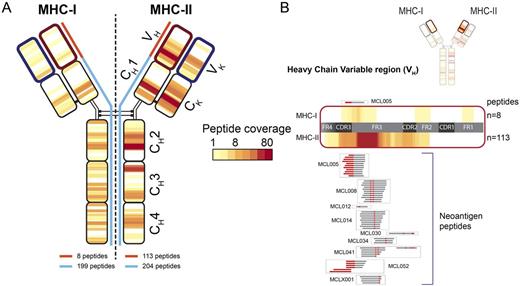Abstract
Neoantigens arising through somatic mutations are increasingly recognized as key tumor antigens driving clinical immune responses. We sought to identify human lymphoma neoantigens through a genomic and proteomic characterization of peptide ligands of major histocompatibility complex class I (MHC-I) and class II (MHC-II) of a cohort of patients with untreated mantle cell lymphoma. Peptide identification was performed through analysis of MHC-I and MHC-II peptide ligands using liquid chromatography and tandem mass spectrometry (LC/MS-MS), and augmented by generating patient-specific proteome databases through tumor:normal whole exome sequencing and targeted immunoglobulin gene sequencing in 17 patients. A total of 66 neoantigen peptides from 9 patients were found to be presented by MHC, and surprisingly all neoantigenic peptides were derived from either the lymphoma immunoglobulin heavy or light chain genes. There was no detectable MHC presentation of hundreds of candidate somatic neoantigenic peptides from other genes despite widespread antigen presentation of the proteome including proteins encoded by germline heterozygous single nucleotide polymorphisms. Clonotypic lymphoma immunoglobulin sequences were among the most commonly presented proteins by both MHC-I and MHC-II, yet MHC-I presentation of variable regions was nearly absent and included only a single neoantigen derived from IGVH. In contrast, the variable region was frequently presented by MHC-II and included neoantigen peptides created through somatic hypermutation or VDJ recombination. Autologous circulating T-cells specific for immunoglobulin-derived neoantigens could be detected using MHC-II tetramers and their frequency dynamically changed with vaccination and therapy. These findings suggest that immunoglobulin derived neoantigens are frequently presented by lymphoma, and represent potential targets for CD4, but not CD8, T-cell mediated therapies.
MHC-I and MHC-II presentation of lymphoma immunoglobulin. (A) MHC-I (left) and MHC-II (right) presented peptides derived from patients' immunoglobulin were mapped to the immunoglobulin domains. Peptides recovered from all seventeen patients are mapped to a schematic of the IgM molecule with a heat map indicating the number of recovered peptides covering each position. (B) Expanded view of the immunoglobulin heavy chain variable region. The heatmap represents the total number of MHC-presented peptides that span that position, including non-neoantigens for MHC-I (above) and MHC-II (below). Neoantigen peptides created by either somatic hypermutation or VDJ rearrangement are mapped above or below the heat map. Red, positions within the recovered peptides which are altered from germline variable genes thus creating neoantigens. Boxes, peptides derived from a single patient.
MHC-I and MHC-II presentation of lymphoma immunoglobulin. (A) MHC-I (left) and MHC-II (right) presented peptides derived from patients' immunoglobulin were mapped to the immunoglobulin domains. Peptides recovered from all seventeen patients are mapped to a schematic of the IgM molecule with a heat map indicating the number of recovered peptides covering each position. (B) Expanded view of the immunoglobulin heavy chain variable region. The heatmap represents the total number of MHC-presented peptides that span that position, including non-neoantigens for MHC-I (above) and MHC-II (below). Neoantigen peptides created by either somatic hypermutation or VDJ rearrangement are mapped above or below the heat map. Red, positions within the recovered peptides which are altered from germline variable genes thus creating neoantigens. Boxes, peptides derived from a single patient.
Newman:Roche: Consultancy. Carlton:Adaptive Biotechnologies: Employment, Equity Ownership. Moorhead:Adaptive Biotechnologies: Employment. Faham:Adaptive Biotechnologies Corp: Employment.
Author notes
Asterisk with author names denotes non-ASH members.


This feature is available to Subscribers Only
Sign In or Create an Account Close Modal